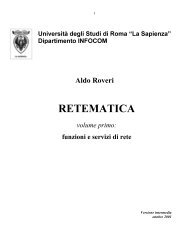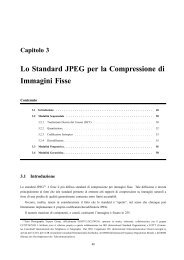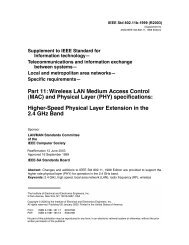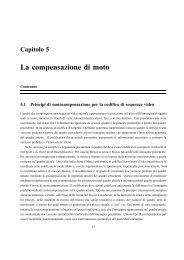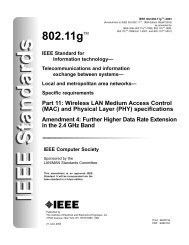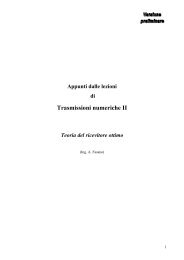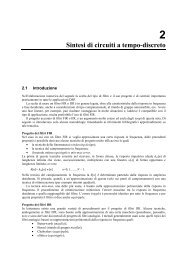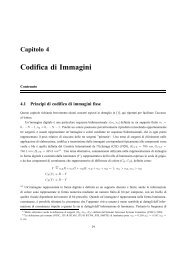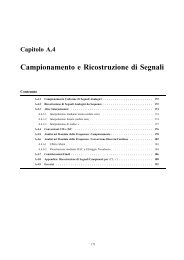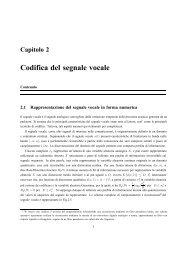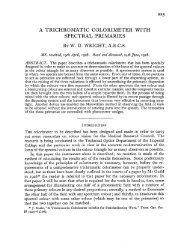Gestione dell'handover verticale in Reti Mobili di ultima ... - InfoCom
Gestione dell'handover verticale in Reti Mobili di ultima ... - InfoCom
Gestione dell'handover verticale in Reti Mobili di ultima ... - InfoCom
You also want an ePaper? Increase the reach of your titles
YUMPU automatically turns print PDFs into web optimized ePapers that Google loves.
In<strong>di</strong>ce<br />
In<strong>di</strong>ce delle Figure<br />
Figura 1: <strong>Reti</strong> <strong>di</strong> nuova generazione................................................................................................. 7<br />
Figura 2:Tipologie <strong>di</strong> reti wireless .................................................................................................... 8<br />
Figura 3: ................................................................................................................................................ 9<br />
Figura 4: WLan Pubbliche................................................................................................................ 10<br />
Figura 5: .............................................................................................................................................. 14<br />
Figura 6: Distribuzione delle frequenze nelle telecomunicazioni............................................... 16<br />
Figura 7: WLan .................................................................................................................................. 32<br />
Figura 8: WiMax: Scenari <strong>di</strong> applicazioni ...................................................................................... 35<br />
Figura 9: <strong>Gestione</strong> della mobilità .................................................................................................... 48<br />
Figura 10: Funzioni IEEE 802.21...................................................................................................... 55<br />
Figura 11: Pila protocollare TCP/IP ................................................................................................ 57<br />
Figura 12: MIP Architecture............................................................................................................ 60<br />
Figura 13: MIP Signall<strong>in</strong>g Procedures .......................................................................................... 62<br />
Figura 14: SIP Re‐Invite Architecture ........................................................................................... 64<br />
Figura 15: SIP Re-Invite Signall<strong>in</strong>g Procedures............................................................................ 65<br />
Figura 16: SIP MMUSE Architecture .............................................................................................. 66<br />
Figura 17: SIP MMUSE Signall<strong>in</strong>g Procedures............................................................................. 68<br />
Figura 18: Procedura VHO P<strong>in</strong>g‐Pong Avoidance Algorithm for Vertical Handover <strong>in</strong><br />
Wireless Overlay Network............................................................................................................... 74<br />
Figura 19: Prestazioni dell’algoritmo VHO P<strong>in</strong>g‐Pong Avoidance Algorithm for Vertical<br />
Handover <strong>in</strong> Wireless Overlay Network ....................................................................................... 75<br />
Figura 20:Procedura dell’algoritmoVHO‐ A New Approach of UMTS‐WLAN Load<br />
Balanc<strong>in</strong>g ............................................................................................................................................ 78<br />
Figura 21: Prestazioni dell’algoritmoVHO A New Approach of UMTS‐WLAN Load<br />
Balanc<strong>in</strong>g ............................................................................................................................................ 80<br />
Figura 22: Procedura dell’algoritmo VHO proposto.................................................................... 91<br />
Figura 23: Simulazione1‐Mappa eterogenea con percorso utente............................................ 109<br />
Figura 24: Simulazione1‐Mappa delle zone <strong>di</strong> copertura della rete WiFi .............................. 110<br />
Figura 25: Simulazione1‐Mappa delle zone <strong>di</strong> copertura della rete UMTS ........................... 110<br />
Figura 26: Simulazione1‐ goodput WiFi UMTS ‐me<strong>di</strong>a............................................................. 111<br />
Figura 27: Simulazione1‐ goodput WiFi UMTS –me<strong>di</strong>a mobile ............................................... 112<br />
Figura 28: Simulazione1‐ goodput WiFi UMTS – spianamento esponenziale........................ 113<br />
Figura 29 Simulazione1‐ goodput con soglia sulla sensibilità ................................................. 114<br />
Figura 30 Simulazione1‐ frequenza <strong>di</strong> VHO con soglia sulla sensibilità................................. 115<br />
Figura 31: Simulazione1 – goodput senza soglia ....................................................................... 116<br />
Figura 32: Simulazione 1 ‐ frequenza <strong>di</strong> VHO senza soglia sulla sensibilità .......................... 117<br />
Figura 33: Simulazione 2 ‐ l’istogramma relativo alla frequenza <strong>di</strong> VHO nel caso MMUSE.119<br />
Figura 34: Simulazione 2 il goodput nello scenario <strong>di</strong> VHO nel caso MMUSE...................... 120<br />
iv



